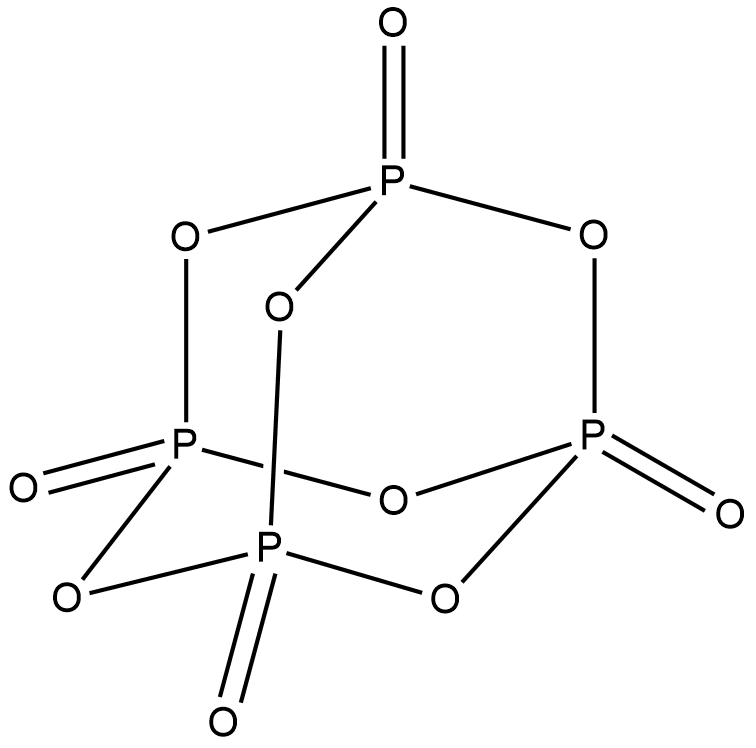
Answer
437.7k+ views
Hint: ${P_4}{O_{10}}$ is an oxide of phosphorus. Its chemical name is phosphorus pentoxide, because it is a dimer of ${P_2}{O_5}$ . In ${P_4}{O_{10}}$ , oxygen is in $ - 2$ oxidation state and phosphorus is in $ + 5$ oxidation state.
Complete step by step answer:
Structure of ${P_4}{O_{10}}$ is shown below.

In ${P_4}{O_{10}}$ , all the phosphorus atoms are $s{p^3}$ hybridised with a tetrahedral structure. $s{p^3}d$ hybridisation is preferred for phosphorus atom over $s{p^3}$ hybridisation. But for ${P_4}{O_{10}}$ , $s{p^3}$ hybridisation is more stable than $s{p^3}d$. Hence ${P_4}{O_{10}}$has four $s{p^3}$ hybridised phosphorus atoms. Option A is correct.
${P_4}{O_6}$ is another oxide of phosphorus. Both ${P_4}{O_6}$ and ${P_4}{O_{10}}$ contains six P-O-P bond and $4$ six membered ring. In ${P_4}{O_6}$ , the atomic orbitals containing lone pairs have more s-character and less p-character. Hence they have shorter bond length. But the bonding orbitals have more p-character and less s-character and hence a longer bond length. But in ${P_4}{O_{10}}$ the bonding orbitals have more $s\% $ character compared to that in ${P_4}{O_6}$ . The bonding orbitals means the P-O bond. Hence ${P_4}{O_6}$ has a higher $s\% $ character in P-O bond than the ${P_4}{O_6}$. Option B is also correct.
From the structure given above, we can see that ${P_4}{O_{10}}$ has a cage like structure. Hence option C is correct.
The terminal P-O bonds in ${P_4}{O_{10}}$ are formed by ${p_\pi } - {d_\pi }$ bonding. p-orbitals of oxygen overlap with empty d-orbitals of phosphorus. The phosphorus atom donates its lone pair to this bonding forming a $\pi $ - back bonding. Hence option D is correct.
Options A,B,C and D correct for ${P_4}{O_{10}}$ .
Note:
Phosphorus can show $ + 3$ and $ + 5$ oxidation states. Hence it forms two oxides ${P_2}{O_3}$ and ${P_2}{O_5}$ with oxidation states $ + 3$ and $ + 5$ respectively. But their monomeric form is not stable. This is the reason why they exist as dimer - ${P_4}{O_6}$ and ${P_4}{O_{10}}$.
Complete step by step answer:
Structure of ${P_4}{O_{10}}$ is shown below.

In ${P_4}{O_{10}}$ , all the phosphorus atoms are $s{p^3}$ hybridised with a tetrahedral structure. $s{p^3}d$ hybridisation is preferred for phosphorus atom over $s{p^3}$ hybridisation. But for ${P_4}{O_{10}}$ , $s{p^3}$ hybridisation is more stable than $s{p^3}d$. Hence ${P_4}{O_{10}}$has four $s{p^3}$ hybridised phosphorus atoms. Option A is correct.
${P_4}{O_6}$ is another oxide of phosphorus. Both ${P_4}{O_6}$ and ${P_4}{O_{10}}$ contains six P-O-P bond and $4$ six membered ring. In ${P_4}{O_6}$ , the atomic orbitals containing lone pairs have more s-character and less p-character. Hence they have shorter bond length. But the bonding orbitals have more p-character and less s-character and hence a longer bond length. But in ${P_4}{O_{10}}$ the bonding orbitals have more $s\% $ character compared to that in ${P_4}{O_6}$ . The bonding orbitals means the P-O bond. Hence ${P_4}{O_6}$ has a higher $s\% $ character in P-O bond than the ${P_4}{O_6}$. Option B is also correct.
From the structure given above, we can see that ${P_4}{O_{10}}$ has a cage like structure. Hence option C is correct.
The terminal P-O bonds in ${P_4}{O_{10}}$ are formed by ${p_\pi } - {d_\pi }$ bonding. p-orbitals of oxygen overlap with empty d-orbitals of phosphorus. The phosphorus atom donates its lone pair to this bonding forming a $\pi $ - back bonding. Hence option D is correct.
Options A,B,C and D correct for ${P_4}{O_{10}}$ .
Note:
Phosphorus can show $ + 3$ and $ + 5$ oxidation states. Hence it forms two oxides ${P_2}{O_3}$ and ${P_2}{O_5}$ with oxidation states $ + 3$ and $ + 5$ respectively. But their monomeric form is not stable. This is the reason why they exist as dimer - ${P_4}{O_6}$ and ${P_4}{O_{10}}$.
Recently Updated Pages
Write the IUPAC name of the given compound class 11 chemistry CBSE

Write the IUPAC name of the given compound class 11 chemistry CBSE

Write the IUPAC name of the given compound class 11 chemistry CBSE

Write the IUPAC name of the given compound class 11 chemistry CBSE

Write the IUPAC name of the given compound class 11 chemistry CBSE

Write the IUPAC name of the given compound class 11 chemistry CBSE

Trending doubts
Fill the blanks with the suitable prepositions 1 The class 9 english CBSE

Which are the Top 10 Largest Countries of the World?

How do you graph the function fx 4x class 9 maths CBSE

Distinguish between the following Ferrous and nonferrous class 9 social science CBSE

The term ISWM refers to A Integrated Solid Waste Machine class 10 social science CBSE

The Equation xxx + 2 is Satisfied when x is Equal to Class 10 Maths

Difference between Prokaryotic cell and Eukaryotic class 11 biology CBSE

Which is the longest day and shortest night in the class 11 sst CBSE

In a democracy the final decisionmaking power rests class 11 social science CBSE




